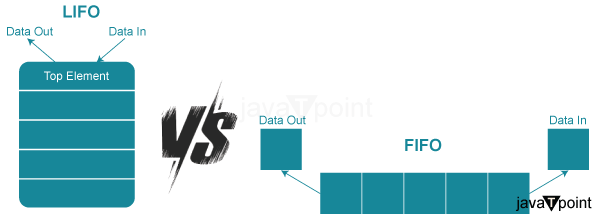FIFO vs LIFO approach in Programming
Introduction:
In the realm of programming, effective data management is critical for optimal performance and resource utilization. FIFO (First-In-First-Out) and LIFO (Last-In-First-Out) are two main approaches to data organization. The order in which data elements are retrieved and processed is determined by these mechanisms. In this article, we will look at the key differences between FIFO and LIFO techniques, as well as their benefits and drawbacks and applications in programming.

FIFO Approach:
The FIFO method is based on a simple principle: the first data element added to a data structure is the first to be deleted. This method is analogous to a queue, where people stand in queue and the one who arrives first is served first. FIFO is commonly implemented in programming utilizing data structures such as queues or linked lists.
Advantages of FIFO:
- Predictable behavior: FIFO guarantees that data is processed in the sequence in which it was received. This predictability is critical in applications that require chronological order, such as real-time systems and message queues.
- Fairness: Because it handles all items equally, FIFO is naturally fair. It is appropriate for cases where fairness is required, such as job scheduling in an operating system, because no element is favored over another.
- Simplicity: Because FIFO is very simple to implement, it is an excellent solution for applications where data management must be as basic as possible.
- Cache performance: In circumstances where cache performance is crucial, FIFO can perform well. When data pieces are accessed sequentially, it can demonstrate good cache behavior.
Disadvantages of FIFO:
- Lack of adaptability: Because it rigidly conforms to the order of insertion, FIFO may not be the best choice for instances where the order of data processing needs to be variable.
- Inefficiency: The FIFO strategy may be inefficient when fresh data is more relevant or older data becomes obsolete. Even if data components are no longer relevant, they can be processed.
- Unsuitable for some algorithms: Some algorithms, such as depth-first search in graph traversal, may not perform well with a strict FIFO approach.
LIFO Approach:
The LIFO method, on the other hand, processes the most recently added data element first. This method is similar to stacking items on top of each other, with the last item placed being the first to be removed. LIFO is frequently implemented in programming utilizing data structures such as stacks.
Advantages of LIFO:
- Efficiency in some scenarios: LIFO can be extremely efficient when the most recent data is more likely to be relevant and older data can be safely ignored. This is especially true for undo/redo procedures and expression evaluation.
- Simplified memory management: LIFO data structures, such as stacks, are simple to create and aid in memory management. They are commonly used in call stacks for function calls and recursion, for example.
- Improved cache performance: When cache performance is critical, LIFO may outperform FIFO because it is more likely to effectively utilize cache lines when processing recent data.
- Flexibility: LIFO can be used to create a variety of algorithms, such as depth-first search in graph traversal and backtracking in problem-solving settings.
Disadvantages of LIFO:
- Unpredictable behavior: When the order of data processing is not tightly maintained, LIFO can provide unexpected results. This can be a concern in situations when keeping a chronological or ordered sequence is critical.
- The risk of resource leaking: If LIFO data structures are not correctly handled, they might result in resource leakage in situations such as memory allocation and deallocation. Items can be added to the stack but never deleted, resulting in memory waste.
- May not be appropriate for real-time systems: The LIFO technique may not be appropriate in real-time systems where keeping a strict order of data processing is critical.
Differences:
| FIFO |
LIFO |
| It refers to the programming approach of first-in-first-out. |
It refers to the programming approach of last-in-first-out. |
| The new element is inserted below the current element in this case, such that the oldest element is at the top and removed first. |
The new element is inserted above the previous element in this case, such that the newest element is at the top and removed first. |
| As a result, the first thing entered in this strategy comes out first. |
As a result, the first thing entered in this strategy comes out last. |
| In computers, the FIFO technique is used as an operating system algorithm to allocate CPU time to each process in the order they arrive. |
In computing, the LIFO technique is a queuing theory that refers to how objects are stored in different types of data structures. |
| Inserting an element into a FIFO takes O(1) time. |
Inserting an element in LIFO has a time complexity of O(1). |
| Queue is the data structure that implements FIFO. |
Stack is the data structure that implements LIFO. |
|

 For Videos Join Our Youtube Channel: Join Now
For Videos Join Our Youtube Channel: Join Now










